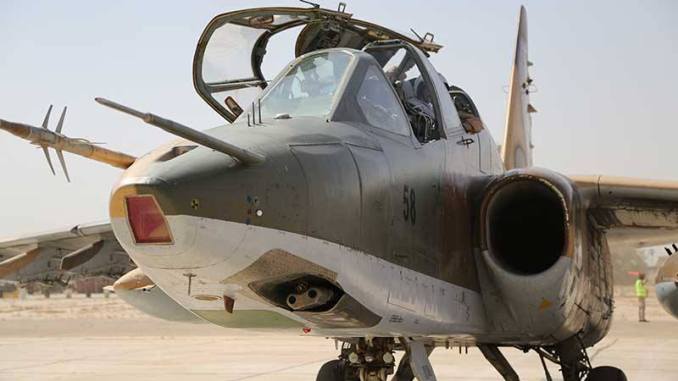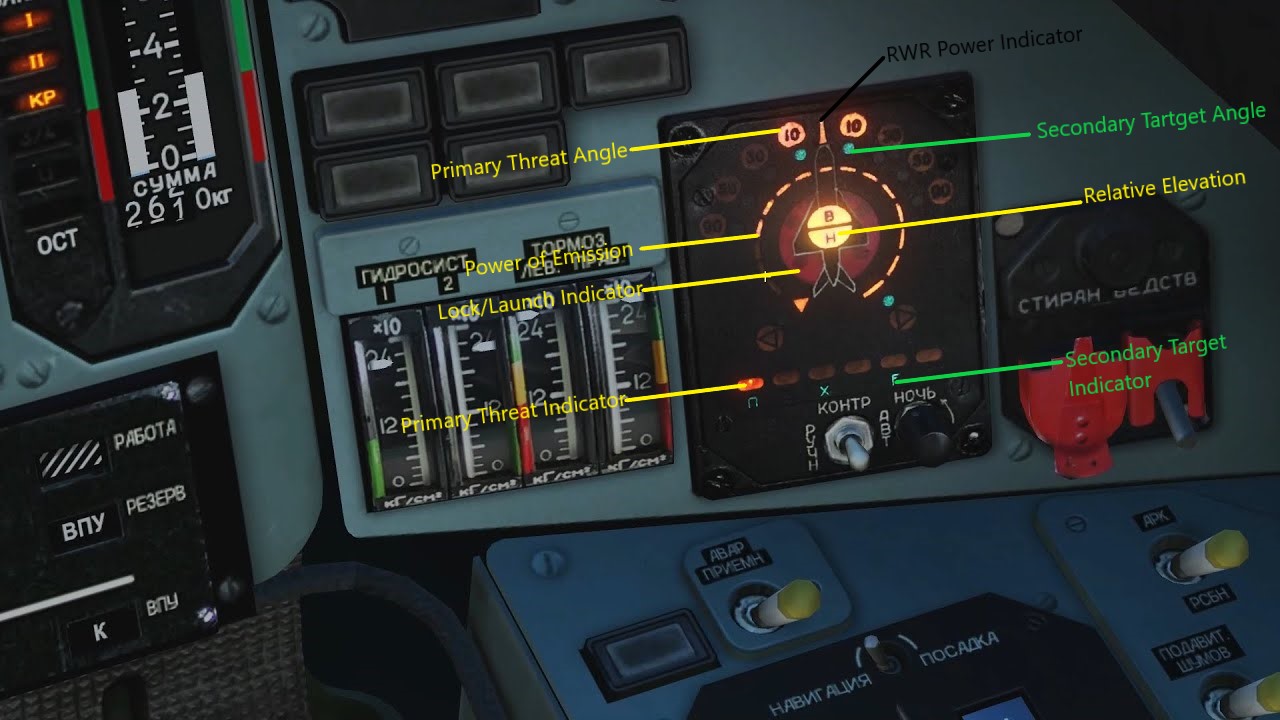Su-25T
NOTE: This guide is currently under a work-in-progress (WIP) state. If you have any information pertaining to the topics or feedback, please relay them over in the Hoggit Discord #wiki-discussion channel. Thanks!
This page is focused on the DCS World SU-25T Frogfoot. Some information may be missing.
The Sukhoi Su-25 Grach (Russian: Грач (rook); NATO reporting name: Frogfoot) is a subsonic, single-seat, twin-engine jet aircraft developed in the Soviet Union by Sukhoi. It was designed to provide close air support for the Soviet Ground Forces.
The Su-25T (Танковый (Tankovy)) is a dedicated anti-tank variant, which has been combat-tested with notable success in Chechnya.
Designed on the Su-25UB frame, the rear seat was removed to accommodate additional avionics giving the SU-25T all-weather and night attack capability. In addition to the full arsenal of weapons of the standard Su-25, the Su-25T can employ the KAB-500Kr TV-guided bomb and the semi-active laser-guided Kh-25ML (and its variants) thanks to the Schkval optical TV and Prichal laser rangefinder/target designator housed in its enlarged nose cone. It can also carry Vikhr laser-guided, tube-launched missiles, which is its main antitank armament. For night operations, the low-light TV Merkury pod system can be carried on the center-line mount under the fuselage.
Contents
Overview
The Sukhoi SU-25T (Танковый (Tankovy)) is a dedicated CAS (close-air-support) aircraft that excels in ant-tank and anti-infantry operations. However, the SU-25T is more than capable of filling roles such as:
- CAS (Close-Air-Support)
- SEAD (Suppression of Enemy Air Defenses)
- Anti-Ship Operations
- High and Low Drag Bombing
The SU-25T is truly a multi-tool of an aircraft and though it is a direct upgrade of the SU-25 in terms of armament and weapons delivery it takes a step back in terms of speed and handling as the added weight dampens the flight characteristics. An easy and forgiving multi-role ground attacker for beginners, a skilled pilot with an understanding of its performance can wreak havoc on the battlefield.
Specifications
General Characteristics
- Crew: 1
- Length: 15.53 m (50 ft 11 in) (including nose probe)
- Wingspan: 14.36 m (47 ft 1 in)
- Height: 4.8 m 15 ft 9 in)
- Empty Weight: 9,800 kg (21,605 lb)
- Gross Weight: 14,440 kg (31,835 lb)
- Max Takeoff Weight: 19,300 kg (42,549 lb)
- Powerplant: 2 x Soyuz/Tumansky R-195 turbojet engines, 44.18 kN (9,930 lbf) thrust each
Performance
- Maximum Speed: 975 km/h (526kn)
- Maximum Mach: Mach 0.79
- Range: 1,000 km (540 nmi)
- Combat Range: 750 km (400 nmi) at sea level with 4,400 kg (9,700 lb) of ordinance and two external 800L fuel tanks
- Servoce Ceiling: 7,000 m (23,000 ft)
- Rate of Climb: 58 m/s (11,400 ft/min)
Cockpit
The cockpit of the SU-25T is a fairly standard design for aircraft of its time. Flight control is done via a center stick and left-hand throttles. The instrumentation is largely made up of analog gauges and indicators. The cockpit itself is a bathtub design composed of multiple welded titanium plates. The armored bathtub design of the cockpit results in cramped conditions, poor forward visibility, and next to non-existent rearward visibility.
The cockpit of the DCS SU-25T is in Russian however there are texture mods that are IC (integrity check) compatible that change the cockpit and instrument labels to English if you so wish.
Cockpit Instruments
The cockpit instrumentation in the SU-25T is made up of analog gauges and illuminated indicators. They can be sorted into the following categories.
- Flight
- Navigation
- Engine Management
- Informational
Flight
Show information such as Airspeed, Angle of Attack and G-Force, Rate of Climb, and Altitude (Radar and Baro)
Information is provided by an attitude direction indicator and a horizontal situation indicator
Engine Management
Informational
Avionics
The DCS SU-25T has both English and Russian localizations available for Avionics.
Avionics Operating Modes
Air to Air Mode
Air to Ground Mode
Fixed Reticle Sight
HUD (Heads Up Display)
HUD Symbology
RWR (Radar Warning Receiver)
The SU-25T is equipped with the SPO-15 Beryoza Radar Warning Receiver which receives incoming radar signals and categorizes incoming radar signals into one of 6 categories as well as identifying the distance, angle, and elevation of the emitting source relative to your aircraft within a 180-degree forward azimuth and -30 to +30 degree forward elevation arc. It is also capable of identifying the launch of radar-guided anti-air missiles.
The SPO-15 operates in two modes; ALL or LOCK. While in ALL the SPO-15 will receive, categorize and warn of all incoming radar threats regardless if they are "locked-on". While in LOCK the SPO-15 will only report radar threats that "lock-on" to the aircraft. This mode can be changed by pressing RShift+R
The SPO-15 communicates radar threats to the pilot through a combination of illuminated enunciators and various tones, the volume of which can be controlled by pressing RAlt+, & RAlt+.
There are 3 different colored enunciators on the SPO-15; Red, Yellow, and Green. Yellow indicates primary threat data and is used to show "relative azimuth", "power of emission", "relative elevation" and "primary threat type". Green indicates secondary threat data and is used to show "relative azimuth" and "secondary threat type". Solid Red indicates active radar lock, flashing red indicates a detected missile launch.
The yellow, numbered circles represent the primary threat angle in degrees azimuth, relative to your nose. If 2 are illuminated it means the threat is between the arc (Example: If 30 and 50 are illuminated it means the primary target is likely 40 degrees azimuth from your nose.) Below these circles are the green "secondary threat" indicators. their function is similar to the yellow "primary threat" indicators but for all secondary threats and will show all secondary threats being detected. In the center are the yellow "power of emission", "relative altitude" and the red "lock/launch" indicators. When a primary threat is detected the red "lock/launch" indicator will turn solid to indicate radar lock alongside a constant high pitched tone. The yellow "power of emission" indicator will illuminate starting on the right and move counter-clockwise to indicate distance from your aircraft. The yellow "relative altitude" indicator will illuminate to show the primary threat's altitude relative to your aircraft. When the red "lock/launch" indicator begins flashing as a rapid high-pitched beeping is heard the missile has been fired and is tracking your aircraft.
RWR Symbology
| П | Airborne |
| З | Long-Range Radar |
| X | Medium-Range Radar |
| H | Short-Range Radar |
| F | Early Warning Radar |
| C | AWACS |
| A | Airborne |
| L | Long-Range Radar |
| M | Medium-Range Radar |
| S | Short-Range Radar |
| EW | Early Warning Radar |
| AW | AWACS |
| B Iluminated | Threat Above |
| H Illuminated | Threat Below |
| Both Illuminated | Threat Co-Altitude |
| Beeping In 3 Second Intervals | Search Radar Contact |
| Solid High-Pitched Tone | Radar Lock Warning |
| Rapid High-Pitched Beeping | Missile Launch Warning |
Weapons Status and Control
Weapons
Roles
SEAD


